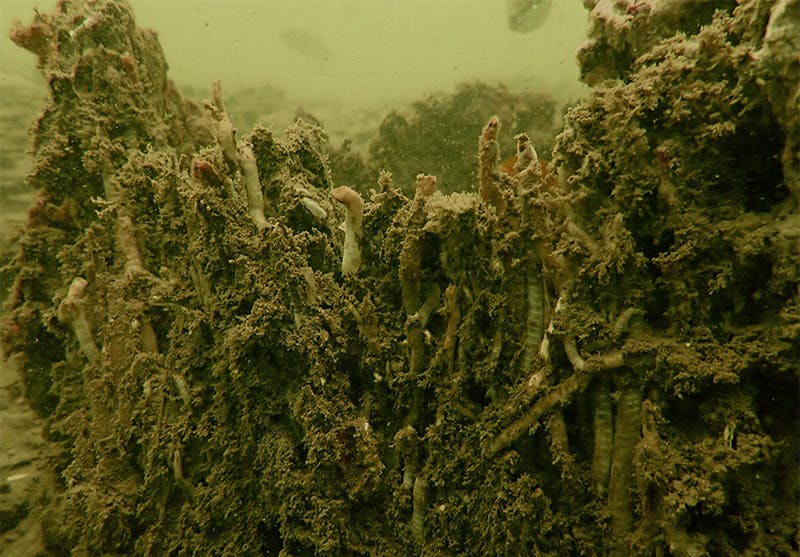The mussel in Dan Distel’s petri dish was barely larger than a grain of rice. As he watched, the golden, semi-translucent bivalve stretched out a long, pale foot and dragged its shell across the plastic. Distel, director of the Ocean Genome Legacy Center, a nonprofit that explores and preserves threatened sea species, was dissecting pieces of wood collected from the remnants of a Pleistocene forest 60 feet underwater off the coast of Alabama. The mussel had been nestled in a crumbling piece of ancient cypress.
Distel had been looking for shipworms—long, fleshy mollusks that eat wood. Nicknamed “the termites of the sea,” shipworms burrow into and devour wood with the help of an array of bacteria living in their gills. Distel and his colleagues are hoping those bacteria will yield potential new antibiotics and other pharmaceutical compounds. But his team is also documenting and preserving any other species that has taken up residence in the drowned forest. The little mussel itself may host symbiotic bacteria that could make useful compounds.

Distel had never seen the mussel before but it looked vaguely familiar. “I thought, ‘What on earth is this thing?’” he said. It reminded him of large mussels typically found in the deep sea. If they turn out to be related, this new species will be the first mussel in that group to be found so close to the ocean surface.
The mussel is just one of the unusual invertebrate species Distel and his fellow researchers have found in the drowned forest. For tens of thousands of years, the forest lay buried in layers of thick mud and sand at the bottom of the Gulf of Mexico, untouched by time. The dense mud protected stumps, seeds, and even pollen from the ravages of decomposition. In 2004, Hurricane Ivan stripped away those layers of protection, exposing the seafloor forest and creating a haven for marine life in an otherwise bare, sandy landscape. Now reef fish flit around the eroded path of an old river bed; anemones grow on the large, buttress roots that flare out from long-dead bald cypress trees; and shrimp, crabs, and other invertebrates have made themselves at home in exposed logs and stumps.
The last time this forest saw the light of day, receding glaciers still covered large parts of North America, locking much of the planet’s water in ice. The sea level in the Gulf of Mexico was several hundred feet lower and the continent was still the territory of mammoths and saber-toothed cats. The towering bald cypress trees, some more than 6 feet wide, stood in a low-lying inland swamp, miles from the coast.
“To find a preserved landscape from that time period is quite rare,” said Kristine DeLong, a paleoclimatologist at Louisiana State University. “The fact that it’s offshore makes it even more unique.”
DeLong has been working in the underwater forest for the last decade, using it to better understand climactic changes in the Gulf and trying to tease apart how it came to be so well preserved. The trees themselves have proved to be too old for carbon dating techniques, but DeLong and her colleagues have been able to estimate that the forest died and was rapidly buried between 50,000 and 70,000 years ago.
He had never seen the tiny mussel before: “I thought, ‘What on earth is this thing?’”
The trees don’t show signs of damage from disease, insects, or fire. The researchers think the forest may have been wiped out in a severe flood or by an influx of salt water from rising seas. Whatever event killed off the forest was sudden, DeLong said. Tree ring records indicate that while the trees were stressed for the last 80 years of their lives, they all died within a single year. Given how well the wood has been preserved—even the bark is intact—the trees must have been buried in mud soon after, which protected them from decomposing.
“This is typically what you would find in a swamp where you don’t have a lot of water mixing and there’s no oxygen,” DeLong said. “It’s kind of like the peat bogs that you hear about in Ireland and in the U.K. that have this great preservation—same kind of thing, except our peat bog is now offshore.”
As sea levels rose, sand covered the mud and all traces of the forest vanished beneath the waves. The forest remained hidden until Hurricane Ivan tore through the Gulf of Mexico in 2004. Ivan had already devastated several Caribbean islands and killed 67 people before making landfall in Alabama with sustained winds around 120 mph. The powerful storm kicked up 90-foot waves in the Gulf, scouring almost 10 feet of sand off the seafloor and unearthing a half-square-mile field of remarkably well-preserved stumps and forest remnants.
Marine animals quickly took advantage of the new habitat. While a wood-eating invertebrate like the shipworm may seem like an odd place to look for a drug compound, researchers have been increasingly turning toward the ocean for new medicines. Many marine organisms, especially those living in high-density ecosystems like coral reefs, use chemical defense systems to protect themselves and their space. Several existing cancer medications, such as Cytarabine, which is used to treat leukemia, have been developed from compounds made by animals living on reefs, and still more promising drugs, perhaps to treat brain cancer, are on their way from the deep sea, reports Hakai magazine.
The crowded marine community that has laid claim to the underwater forest presents an opportunity for scientists to find unusual molecules made by creatures jockeying for space in a unique new ecosystem. And symbiotic bacteria—microbes living inside another creature to the benefit of them both—might be a good place to start because they’ve already proven they can coexist with animal cells.
“They’ve carved out this nice little place to live, and they want to protect that,” said Bailey Miller, a chemist at the University of Utah who has been analyzing the shipworm bacteria. “Our hypothesis is they’re making a molecule that can kill the competition without killing the host. And we think that would translate into molecules that would work for antibiotics for another living system, like us.” If these molecules can kill bacteria without harming us, they could be valuable additions to the medicine cabinet.
Shipworm symbionts are also unusually easy to grow in the lab. Many symbiotic bacteria come to depend heavily on their hosts for survival, losing the genes necessary to survive on their own. But shipworm symbionts still have large genomes and are able to thrive independently in a lab setting, Miller said.
Antibiotics could be derived from the marine organisms’ chemical defense systems.
The researchers have already isolated several hundred bacterial strains from shipworms collected at the underwater forest and identified about 20 new species. They are in the process of sequencing the genomes of those bacteria to look for potential antibiotic compounds.
The process takes some time. After sequencing the bacterial genome, the researchers look for groups of genes that make the kind of complex molecule that could be an antibiotic. When they find ones that look promising, they check the genomes of other shipworm bacteria for similar gene clusters—if they see something in multiple strains of bacteria, it’s more likely to be important for symbiosis and a molecule that could be useful. They then isolate those specific compounds and test them.
Miller and his colleagues have had some success with this technique, using shipworm symbionts from the United States, the Philippines, and Brazil. They identified a gene cluster found in bacterial strains across these locations and the antibiotic it produced was able to kill drug-resistant strains of Acinetobacter, a species of bacteria that spreads easily in hospitals and can cause dangerous infections in a patient’s lungs, blood stream, or urinary tract. They hoped the shipworms in the Gulf would help them identify new gene clusters to examine, not just point them to the same ones they had already found.
“We were worried that we would get all of the bacteria, and we would sequence them, and we would just have more of what we had already seen,” Miller said. “But what we found is that, as we keep on adding new strains in, we get more and more and more of these biosynthetic gene clusters.”
Distel and Miller visited the underwater forest in late 2019 with a team of researchers to collect their first set of samples. Unfortunately, neither scientist can really claim to have seen it. The water was so murky with sediment that they collected pieces of wood from the site almost entirely by feel. “The visibility and the current and everything changes so much there,” said Grant Lockridge, a diving safety officer at the Dauphin Island Sea Lab. “Sometimes you can go down there and you can almost see it from the surface, and other days you go out there and it’s like chocolate milk—you can see absolutely nothing.”
Follow-up trips have been delayed by the COVID-19 pandemic, but that hasn’t stopped the researchers from continuing to add to their microbial library. They have contracted Lockridge to collect shipworms on their behalf. He leaves fresh blocks of cypress at the site as bait, retrieving them after several months. Some of the blocks end up buried in shifting sands, swept away by storms, or crumbled to pieces by industrious invertebrates. But those that remain are honeycombed with shipworm burrows, wriggling with life. Lockridge packs them into trash bags, seals them inside Styrofoam coolers, and overnights them to Distel’s lab in Massachusetts.
Even when visibility is good, the forest rarely looks the same twice, Lockridge said. Researchers have counted as many as 50 tree stumps standing above the sediment when the area was swept clear. Other days, many of those trees are visible only as a circle of wood poking out of the sand. And each passing hurricane has the potential to bury the whole thing again—or scour a new area clean, unearthing more forest.
DeLong knows there are more trees out there. As her team collects data on this current site, they’re working on models to predict where other sections of forest might lie beneath the seabed. This summer, they’re bringing in a 3-D imaging system that has been used to detect buried shipwrecks to scan likely areas. Local fishermen have also suggested there are as many as eight different sites with already-exposed trees, although they’re cautious about sharing the locations—they want to protect their fishing spots from competitors and from companies looking to harvest the wood. Since the forest’s discovery became public, DeLong and others who know its exact location have been repeatedly contacted by commercial interests hoping to salvage the cypress to make high-end furniture.
Last summer, half a year after Hurricane Sally swept through the area, DeLong found another group of cypress stumps poking out of the sand. “We had a hypothesis of where we might find another site, so we went out and surveyed it—it was close by and we had the time to do it—and lo and behold, we found more stumps,” DeLong said.
Each newly revealed section of trees could help DeLong understand the conditions that led to the forest’s burial and help climate modelers predict how current rising seas may reshape coastal areas. And as marine communities move to take advantage of these unexpected habitats, the potential for new species and new medicines only increases. “We’re going to be working on this site for the rest of our careers,” DeLong said. “It is a gold mine. And we just keep finding more new things.”
Every discovery reveals new lines of research to explore. The researchers want to figure out where the little golden mussel fits into the evolutionary tree. Did some mussel larvae from the deep sea get swept into shallow water and evolve to survive? Or did shallow water mussels get carried into the depths by sinking wood and learn to thrive in the depths? And where was this creature living before tree stumps poked up from the sand?
Only time, and more research, will tell. But for the moment, Distel and his colleagues have dubbed the curious bivalve “submaresilva”—Latin for “undersea forest.” ![]()
Lead photo: Andrew Astbury / Shutterstock































